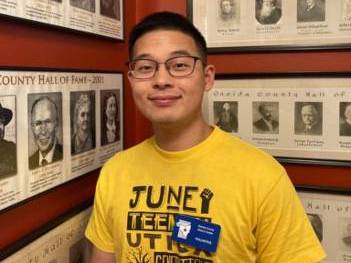Ray Zhang ’24 is one of 26 student fellows who completed research with a community-based organization in upstate New York this summer as a part of the Upstate Institute Summer Field School.
What is it like to work in a museum for a summer? As a student interested in the museum field, I’m grateful to have had the opportunity provided by the Upstate Institute to work with staff from the Oneida County History Center. My project this summer with the history center was called Rejuvenating Local History and had me take a hallmark event about the center’s core exhibition, the Historical Hall of Fame, and make it accessible to virtual visitors and connect with on-site visitors in a new, engaging manner.
Founded in 1876, the Oneida County History Center (OCHC) is a public nonprofit organization located in the historical district of downtown Utica. The center cares for a growing collection of more than 250,000 documents and books, tens of thousands of images (photographs, paintings, slides, drawings, etc.), and thousands of artifacts from the city of Utica and surrounding Oneida County.
As an area rich in its remarkable cultural and historical heritages, Oneida County was the stage for many significant events in the United States. From the Battlefield at Oriskany to the Boilermaker Road Race, the Native Americans of the Six Nations who first called this land home and the free slaves who shaped local and national destinies through the underground railroad, Oneida County is filled with important events and fascinating figures. Therefore, the mission of OCHC is to protect and preserve the past of Oneida County and central New York for present and future generations, and continue to make history alive today. The history center seeks to make this rich heritage readily available to researchers, families, and students, enhancing the community’s knowledge and appreciation of its history.
The center has a number of permanent exhibits on display, such as exhibits about the Oneida County Freedom Trail, the cotton mill industry, the First Church of Christ, and the Great War. Among these different exhibitions, one of the most important exhibitions is the Oneida County Historical Hall of Fame and Living Legends. As the oldest permanent exhibition in the museum, the Historical Hall of Fame first started in 1946, and a Living Legend category was added in 2000. Each year, three to five new members are inducted into both categories. These new members are celebrated with an awards dinner and recognized in the permanent exhibit. Inductees include world-renowned inventors, prominent politicians, and nationally exhibited artists, all with strong connections to Oneida County. The goal of the Hall of Fame is to honor and record the historical contributions of Oneida County citizens to its community and the world.
My project, Rejuvenating Local History, focuses on the design and implementation of an interactive, digital component to the Historical Hall of Fame gallery. With the abundant primary and secondary sources ranging from videos to family genealogy files based on the biography of each individual figure from the Historical Hall of Fame, I had the opportunity to create a virtual exhibit that can be accessed through the history center website.
Moreover, my project included many interactive elements in the virtual exhibition that aim to appeal to visitors of all ages and go beyond reading text panels. The implementation of self-guided activities as part of my project includes various forms of media I developed, such as podcasts, interview videos, and other related museum exhibitions. These programs not only enriched the content of the Hall of Fame exhibition but could also be reused by the OCHC for future inductees.
In addition, I assisted other museum board members to collect this year’s nominations for the Hall of Fame and the Living Legends from the public by writing and editing a biography for each nominee, contacting local businesses to plan for this year’s award ceremony venues in the fall, and creating multiple social posts for museum summer events such as kids story hours, documentary filming, and a family scavenger hunt around the city of Utica and Oneida County.
Rejuvenating Local History helps the history center share its knowledge with a larger audience via the internet and attract new visitors to experience Oneida County history from a new perspective. This project highlights the OCHC’s relevance to the upstate community as an educational institution and provides access to its great resources from anywhere in the world.
Furthermore, my project will reinvigorate the Historical Hall of Fame Gallery and enable the audience to engage with the history of these significant individuals. Sharing Oneida County’s history is important to the mission of the history center because it creates knowledge that allows the community to take pride in their shared heritage and cultural bonds.
As a student majoring in history and museum studies, I really value my experience working in OCHC as a Field School Fellow for the first time. By working with many professional museum curators and local historians, I had the chance to learn more about the mechanism, structure, and significance of nonprofit organizations while also improving my research skills with access to different databases and museum collections at the same time. Plus, I gained knowledge in exhibit development, gallery design, and event planning through hosting multiple public talks and visiting other local museums.
Through the development of my digital project, I become more aware of the crucial roles of digital media and virtual programs in the museum field today. The field requires strong computer skills and intense use of online tools including Microsoft Office, Google G Suite, Wix, Canva, and Photoshop to conduct my research and virtual website design. These helpful skills I learned in this fruitful 10-week period can be applied not only in my project but also in a variety of settings, providing me with real-world introductions to the work of museum curation and nonprofits.
